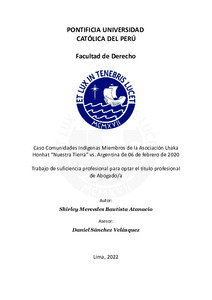El sistema se apagará debido a tareas habituales de mantenimiento. Por favor, guarde su trabajo y desconéctese.
Caso Comunidades Indígenas Miembros de la Asociación Lhaka Honhat “Nuestra Tierra” vs. Argentina de 06 de febrero de 2020
Abstract
Este informe jurídico tiene como finalidad analizar la sentencia del Caso Comunidades
Indígenas miembros de la Asociación Lhaka Honhat (Nuestra Tierra) vs. Argentina,
emitida por la Corte Interamericana de Derechos Humanos el 6 de febrero de 2020,
destacando los argumentos principales que consolidan el enfoque de la justiciabilidad
directa de los derechos económico, sociales, culturales y ambientales, los denominados
derechos “DESCA”. En ese sentido, se describirá el razonamiento interpretativo que
realizó la Corte IDH sobre el artículo 26 de la Convención Americana de Derechos
Humanos (CADH) basándose en los criterios de interpretación sistemática, dinámica y
evolutiva. De esta manera, se reconoce el carácter autónomo de cada derecho DESCA,
como el derecho a un medio ambiente sano, lo cual, nos genera gran expectativa en el
alcance de protección a la naturaleza y sus componentes en sí mismos, incluso sin que
exista evidencia o certeza de afectación al ser humano. Para realizar este informe, hemos
utilizado el método dogmático, debido al objeto de estudio, que se circunscribe en
normas o conceptos jurídicos, tratados internacionales, instituciones jurídicas que derivan
del cuerpo jurisprudencial del Sistema Interamericano (SIDH). Sumado a ello, nos hemos
apoyado de herramientas metodológicas de carácter documental para la búsqueda y
sistematización de información. The purpose of this legal report is to analyze the judgment of the Caso Comunidades
Indígenas miembros de la Asociación Lhaka Honhat (Nuestra Tierra) vs. Argentina,
issued by the Inter-American Court of Human Rights on February 6, 2020, highlighting
the main arguments that consolidate the approach of direct justiciability of economic,
social, cultural and environmental rights (ESCER). In this sense, we will describe the
interpretative reasoning of the Inter-American Court on Article 26 of the American
Convention on Human Rights (ACHR) based on criteria of systematic, dynamic and
evolutionary interpretation. In this way, the autonomous character of each of these rights
is recognized, and on the basis of this autonomy and the content of the protection, the
right to a healthy environment generates a great expectation in the scope of the protection
of nature and its components in themselves, even without evidence or certainty of human
involvement. In preparing this report we have used the dogmatic method, due to the
object of study, which is circumscribed in legal norms or concepts, international treaties,
legal institutions derived from the jurisprudence of the Inter-American System of Human
Rights. In addition to this, we have relied on methodological tools of a documentary
nature for the search and systematization of information.
Temas
Derecho ambiental internacional
Derechos humanos--Jurisprudencia
Corte Interamericana de Derechos Humanos--Jurisprudencia
Comunidades nativas y medio ambiente
Derechos humanos--Jurisprudencia
Corte Interamericana de Derechos Humanos--Jurisprudencia
Comunidades nativas y medio ambiente
Para optar el título de
Abogado
Collections
The following license files are associated with this item:





